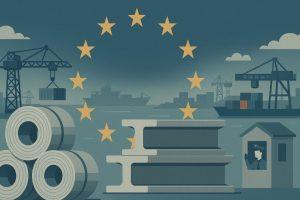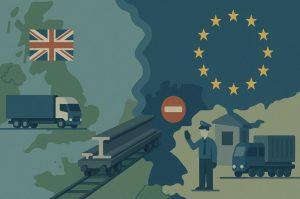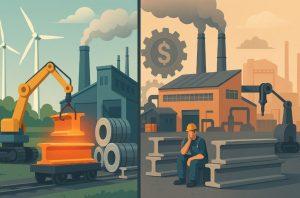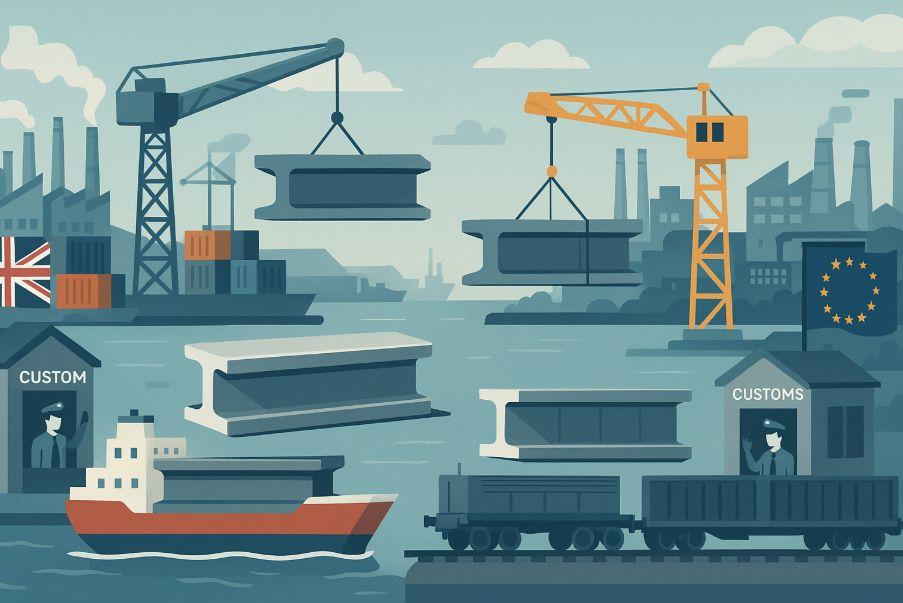The European Union’s steel tariffs have become a defining feature of its trade and industrial policy, shaping not only market dynamics within Europe but also influencing global trade relations.
These measures, originally introduced as safeguards against steel dumping and market oversaturation, continue to evolve in response to economic shifts, environmental priorities, and geopolitical developments.
As the EU balances protecting domestic industry with honouring its commitments to free and fair trade, the implications of these tariffs stretch far beyond European borders.
From UK exporters adjusting post-Brexit to policymakers navigating new environmental regulations like the Carbon Border Adjustment Mechanism, the effects are wide-ranging and complex.
This article explores the origins, structure, and ongoing consequences of EU steel tariffs offering clarity on how they impact businesses, international partners, and the future of the global steel market.
What Are EU Steel Tariffs?

EU steel tariffs are trade measures introduced to shield the European steel industry from unfair competition and oversupply. These tariffs first came into force in 2018 in response to mounting global concerns over steel dumping, where countries, particularly China, were accused of selling steel at artificially low prices.
The decision to introduce these tariffs was also triggered by the United States’ move under the Trump administration to impose steep duties on steel imports. The EU feared this could redirect excess steel to its own markets, potentially destabilising the regional industry.
As a result, the European Commission implemented safeguard measures, primarily in the form of tariff rate quotas, to strike a balance between maintaining access to imported steel and protecting local production.
These measures, compliant with World Trade Organization (WTO) rules, were designed not only to address economic concerns but also to preserve European jobs and uphold fair trade standards across member states.
How Do EU Steel Tariffs Affect International Trade Policy?
EU steel tariffs have had a profound impact on global trade relations. They have introduced a layer of complexity into how steel is traded internationally, reshaping supply chains and prompting policy reactions from major economies such as the United States, China, Turkey, and India. Many of these countries have challenged the EU’s measures at the WTO, arguing that the tariffs are overly protectionist and disruptive to free trade.
On the diplomatic front, these tariffs have influenced broader trade discussions and agreements, particularly between the EU and its partners. They’ve often been at the centre of negotiations concerning market access, fair competition, and industry decarbonisation.
Furthermore, these policies have amplified the need for closer coordination between national governments and supranational organisations. As international trade continues to evolve, the EU’s position on steel tariffs remains a pivotal reference point in shaping future economic alliances and resolving disputes.
What is the EU’s Current Tariff Rate Quota System for Steel?
The EU implements its steel tariffs through a system known as Tariff Rate Quotas (TRQs). This approach allows a specific volume of steel products to enter the EU market without additional tariffs. Once the quota is exceeded, imports are subject to a 25% duty.
These quotas are divided into country-specific and global categories. For instance, major exporters such as Turkey, Russia (prior to sanctions), and India have dedicated quotas, while other countries share access to global quotas. Quotas are monitored quarterly, and once a quota is filled, any further imports from that country are automatically subject to tariffs until the next reset period.
The system is both structured and stringent, aiming to offer predictability to traders while ensuring that European producers are not overwhelmed by a sudden flood of cheaper imports. However, critics argue that the rigid nature of TRQs can hinder supply chain responsiveness, especially during periods of fluctuating demand or economic uncertainty.
How Are Uk Steel Exporters Impacted by EU Steel Tariffs Post-brexit?

Since the United Kingdom’s departure from the European Union, UK steel exporters have encountered new trade barriers that did not exist while the country was still part of the single market. Prior to Brexit, British steel could flow freely across EU borders without quotas or tariffs. That is no longer the case.
Now classified as a third country, the UK must compete for access within the EU’s TRQ framework. British exporters face capped quotas, and exceeding these limits results in the imposition of a 25% tariff on excess goods. This shift has introduced logistical challenges and increased costs for UK steelmakers.
Companies such as Tata Steel and British Steel have had to adjust rapidly, investing in compliance mechanisms and revisiting their export strategies. The industry has also voiced concerns over administrative burdens and reduced competitiveness in one of its closest and historically most important markets.
The UK government has explored bilateral talks and trade adjustments to mitigate these issues, but for now, EU tariffs continue to act as a considerable hurdle for British steel firms hoping to retain their European market share.
What Role Does the Eu-us Steel Agreement Play in Shaping Tariffs?
In 2021, a pivotal agreement between the European Union and the United States marked a turning point in steel trade relations. This deal aimed to resolve the long-standing tariff conflict initiated during the Trump administration, where both parties imposed duties on each other’s steel and aluminium products.
Under the terms of the agreement, the EU suspended certain tariffs on US imports while introducing a revised system of tariff rate quotas for American steel. In return, the US lifted its Section 232 tariffs on a defined volume of EU steel. Beyond this, the agreement laid the groundwork for a more cooperative relationship on industrial decarbonisation and environmental trade standards.
This deal signified more than just tariff relief; it reflected a renewed commitment to multilateral trade cooperation and climate-conscious policy development. It also raised hopes among industry players and policymakers for future resolutions of other tariff disputes.
The EU-US agreement serves as a case study in how tariff-related tensions can be addressed through diplomacy and mutual understanding rather than prolonged trade wars.
How Does the Carbon Border Adjustment Mechanism (CBAM) Influence Steel Tariffs?
The introduction of the Carbon Border Adjustment Mechanism (CBAM) has added a new dimension to EU steel trade policy. CBAM is designed to place a carbon price on imports of high-emission products, including steel, to prevent what’s known as “carbon leakage.” This occurs when companies move production to countries with looser climate regulations, undermining EU efforts to reduce global emissions.
Initially implemented in a transitional phase in 2023, CBAM will become fully operational by 2026. From then on, importers will be required to pay a charge equivalent to the carbon price paid by EU producers under the Emissions Trading System (ETS).
This policy ties environmental goals directly into trade frameworks. For steel exporters targeting the EU market, especially those in countries without a comparable carbon pricing scheme, CBAM represents a significant cost consideration.
While the measure has been praised for reinforcing climate commitments, it has also sparked debate over its compatibility with WTO rules and its potential to create new trade frictions with developing economies.
Are EU Steel Tariffs Protecting or Harming the European Steel Industry?

The impact of EU steel tariffs on the European steel sector is mixed and depends largely on one’s position in the supply chain. From the perspective of European steel producers, the tariffs have provided a buffer against the flood of low-priced imports, helping to stabilise domestic prices and protect jobs. This protection has been particularly crucial during volatile economic periods and amid global disruptions such as the COVID-19 pandemic.
However, downstream industries such as construction, automotive, and manufacturing have voiced concerns. These sectors often rely on affordable steel to maintain competitiveness and fear that tariffs have pushed up prices while limiting supplier diversity.
There’s also the broader question of innovation. Some experts argue that overprotection can lead to complacency, deterring investment in new technologies or cleaner production processes. Nonetheless, supporters of the tariffs insist they’re necessary to give European producers the breathing space they need to modernise and decarbonise.
Ultimately, while the tariffs have delivered short-term benefits to certain segments of the industry, their long-term value will depend on how effectively the European steel sector uses this period of protection to innovate and adapt.
What Are the Future Implications of EU Steel Tariffs for the Global Steel Market?
Looking ahead, EU steel tariffs are poised to play a defining role in the evolution of the global steel market. As the world pivots towards sustainability and digital transformation, tariffs could either become tools for constructive change or obstacles to progress.
The push for green steel steel produced with minimal carbon emissions is gaining momentum. The EU’s support for environmentally conscious production, including its alignment with CBAM, may encourage other countries to adopt similar standards. This shift could redefine competitive advantage in the steel industry, making environmental performance as important as price and volume.
At the same time, geopolitical events continue to shape trade flows. Conflicts, economic sanctions, and the reorganisation of global alliances are likely to influence who trades with whom, and under what conditions.
The EU’s ability to balance protectionism with cooperation, and its willingness to adjust tariffs in response to shifting realities, will determine whether it remains a global leader or risks isolation in an increasingly interconnected market.
How Should Uk Businesses Adapt to Changes in EU Steel Tariffs?
For businesses across the UK engaged in steel trade, the changing tariff landscape requires a strategic response. It’s essential for companies to develop a thorough understanding of EU tariff structures, especially the rules governing TRQs and the conditions under which additional tariffs apply.
Supply chain diversification is becoming increasingly important. Businesses that previously relied heavily on EU customers must now look to new markets while building flexibility into their sourcing and distribution networks. Adopting digital trade tools and staying abreast of regulatory changes particularly those involving CBAM will also be key.
Additionally, UK companies should engage actively with industry associations and government bodies to advocate for favourable trade conditions and gain early insights into policy shifts. Remaining informed and adaptive is critical to managing costs, maintaining compliance, and seizing new opportunities amid evolving trade dynamics.
Conclusion
EU steel tariffs represent more than a simple trade defence tool; they are a strategic response to a host of global challenges from economic protectionism and climate change to geopolitical tensions and industrial competitiveness.
While they have provided the European steel sector with a degree of protection and stability, they have also introduced friction in trade relationships, particularly with close partners like the UK and the US.
Looking ahead, the EU’s ability to adapt these tariffs in line with sustainability goals and shifting market needs will be critical. For UK businesses and global exporters, staying informed and agile is essential to navigating this landscape.
Understanding the nuances of the EU’s approach to steel trade from quota management to climate-linked mechanisms like CBAM will help stakeholders make smarter, more resilient decisions in an increasingly complex global economy.
FAQs
What is the purpose of EU steel tariffs?
The main purpose is to protect the European steel industry from oversupply and unfair pricing practices, especially dumping by non-EU exporters.
How has Brexit changed UK steel trade with the EU?
Post-Brexit, UK steel exports are now subject to the EU’s quota and tariff system, which has introduced limitations and higher costs.
Does the EU still use safeguard measures on steel?
Yes, the EU’s safeguard measures remain in place through a quota-based system that applies tariffs once thresholds are exceeded.
Is CBAM replacing traditional steel tariffs?
Not entirely. CBAM is an additional mechanism focused on carbon emissions, complementing but not replacing existing trade tariffs.
Can steel producers in non-EU countries avoid CBAM charges?
They may be exempt if their home country has an equivalent carbon pricing system, but they must still report emissions data.
Are EU steel tariffs legal under international law?
The EU maintains that its tariffs comply with WTO rules, but several countries have launched disputes challenging their fairness.
How are steel users in the EU affected by tariffs?
Manufacturers and construction firms often face higher prices and reduced availability, which can impact competitiveness and project timelines.









Leave feedback about this